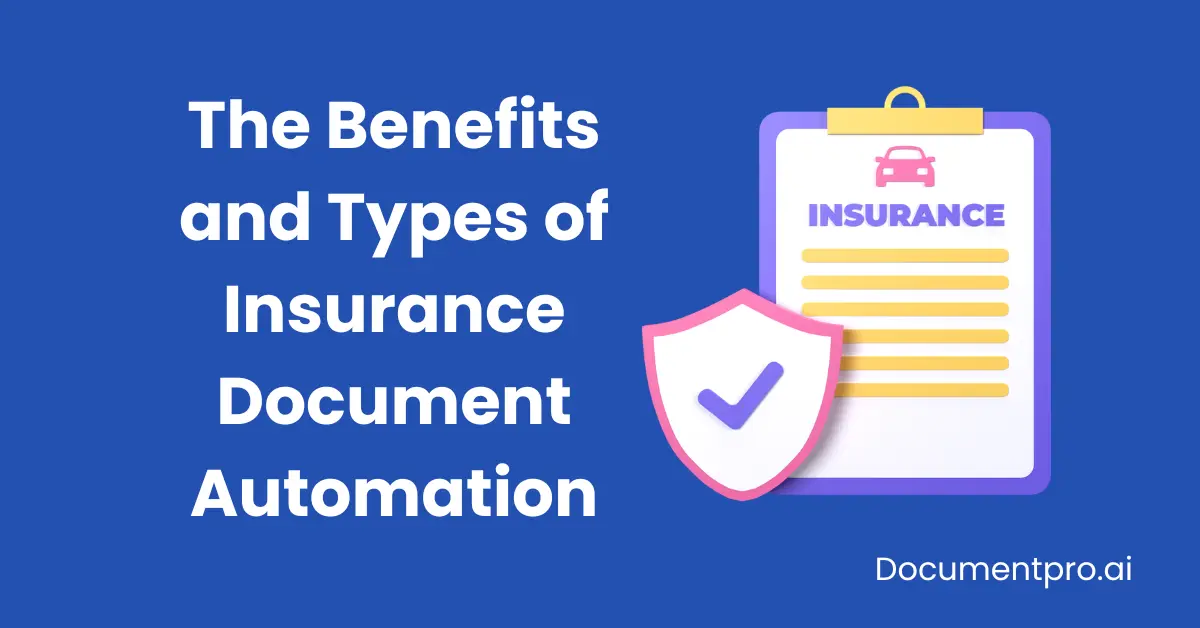
Insurance companies handle large amounts of paperwork daily, including policies, claims, and customer information. Automating document processing has become crucial in enhancing operational efficiency. In this article, we will explore how insurance companies benefit from automated document processing, focusing on its impact on various types of insurance documents and providing examples of how this technology is applied.
1. What is Automated Document Processing( Insurance Document Automation) in Insurance
Automated document processing involves using AI-powered software and machine learning technologies (LLMs) to streamline document handling. This automation significantly reduces the need for manual intervention, leading to faster processing times, reduced errors, and overall better management of insurance-related documents.
2. Types of Insurance Documents and Examples
Insurance companies deal with a variety of documents daily. Below are some common types of insurance documents, along with examples of each:
2.1 Policy Documents
Examples:
- Homeowners Insurance Policy: This document outlines the coverage provided by the insurer for a customer's home, including the conditions and exclusions.
- Auto Insurance Policy: Specifies the types of coverage offered, such as liability, collision, and comprehensive coverage, along with the terms and conditions.
Automation helps streamline the creation, renewal, and storage of these documents, ensuring customers receive updated policies without delays.
2.2 Claims Forms
Examples:
- Health Insurance Claim Form (CMS-1500): Used to file health insurance claims with the insurance company for medical services.
- Auto Accident Claim Form: A document filed by a customer after an accident detailing the incident and the extent of damages.
With automation, these claims can be processed instantly, with data extracted and analyzed in real time, speeding up approvals.
2.3 Data Extraction from Invoices and Billing Statements
Examples:
- Premium Billing Statement: Sent to policyholders detailing their due premiums, payment schedule, and other billing details.
- Renewal Notices: Automated reminders that inform policyholders about upcoming renewals and payments.
Automating the generation and dispatch of these documents helps reduce errors and ensures timely payments.
2.4 Underwriting Documents
Examples:
- Risk Assessment Reports: These documents evaluate potential risks associated with a policyholder and are crucial for setting premiums and determining coverage.
- Medical Underwriting Forms: Used for life or health insurance policies to assess the applicant’s medical history and health risks.
Automation allows underwriters to access and analyze historical data faster, helping them make more accurate and informed decisions.
2.5 Legal Contracts
Examples:
- Third-Party Liability Agreement: Legal contracts that define the liabilities of an insurance provider to third parties involved in a claim.
- Reinsurance Agreements: Contracts between insurance companies and reinsurers outlining terms of coverage, limits, and responsibilities.
Automating legal contracts reduces the chances of errors and ensures that legal standards and compliance are met.
3. How Insurance Companies Benefit from Automated Document Processing
Automating document processing has several benefits for insurance companies:
3.1 Faster Claims Processing
One of the most significant advantages of automation is the quick handling of claims. When claim forms and supporting documents are processed automatically, insurance companies can reduce the turnaround time for approvals, allowing for faster settlements. This leads to higher customer satisfaction.
3.2 Cost Savings
Manual document processing requires extensive labor, which can be costly over time. By adopting automated solutions, insurance companies reduce labor costs and save money on storage and printing while eliminating the need for manual data entry, which reduces errors and the cost of rectifying them.
3.3 Improved Accuracy and Compliance
Automation tools, particularly those using AI, have a high degree of accuracy when processing documents. This reduces the chances of human errors, such as incorrect data entry or missing information. Moreover, automated systems can ensure that documents meet regulatory compliance standards by checking for required fields and data formats.
3.4 Enhanced Customer Experience
With automated systems, customers can receive quick responses to their queries, whether requesting a policy document, submitting a claim, or seeking an update on their insurance status. The faster, more efficient service results in higher customer satisfaction and loyalty.
3.5 Streamlined Document Management
Insurance companies deal with thousands of documents daily. Automated document management systems enable efficient document storage, retrieval, and categorization. This streamlining improves organizational workflow and allows easy access to necessary information.
3.6 Better Risk Assessment
Automating underwriting documents allows insurers to assess risks more accurately. By integrating historical data and advanced algorithms, AI systems help underwriters analyze risks faster and more thoroughly, which helps in making more informed decisions.
5. Future of Insurance Document Automation
The future of automated document processing in insurance is bright. As AI and machine learning technologies evolve, we can expect even more accurate, faster, and scalable solutions to be implemented. Insurance companies will likely adopt more advanced systems that integrate with other digital tools, such as blockchain, for secure, transparent document processing.
Also Read: Top 6 Best Data Extraction Tools in 2024
Faqs:
Why is Automation Needed in the Insurance Industry?
Automation is essential in insurance to reduce manual errors, enhance efficiency, improve customer service, ensure compliance, and lower operational costs.
What Are the Benefits of Machine Learning in Auto Insurance?
Machine learning improves risk assessment, fraud detection, claims processing, and customer retention and offers usage-based insurance through telematics.
How Does AI Help in the Insurance Industry?
AI speeds up claims processing, enhances customer service, improves underwriting, prevents fraud, and automates document handling for greater efficiency.
Conclusion
Insurance companies gain considerable advantages from automated document processing, including faster claims handling, cost savings, enhanced accuracy, and a better customer experience. By automating the management of various insurance documents, insurers can streamline operations, reduce risks, and stay competitive in a rapidly evolving industry.
